Gigabyte GA-Z77X-UP7 Review: Special LGA 1155 Overclocker Mainboard

This mainboard has a ton of peculiarities and two major features distinguishing it from the others. The first one is an extremely powerful voltage regulator circuitry with 32 phases for the processor alone. The second one is a special individual graphics card slot, which will ensure that your single graphics card works at the highest speed possible, even though this mainboard is originally designed for multi-card graphics configurations.
Gigabyte uses a pretty simple and overall very easy to understand model naming system for their mainboards, which allows to easily determine the feature of a specific product just from its model name alone. The abbreviation “Z77” in the Gigabyte GA-Z77X-UP7 name indicates that this mainboard is based on Intel Z77 Express chipset, which means that it is designed for LGA 1155 processors. the “UP” index will tell experienced users that the board is engineered using Ultra Durable 5 technology, and the last number “7” stands for the highest class of products with extensive functionality. However, you may be surprised to find out that this particular product is targeted for overclockers, although you may have actually guessed that it is so. Only the very first specific overclocker mainboard from Gigabyte had a distinctive model name – Gigabyte GA-X58A-OC, but the next model already boasted a model name, which didn’t really stand out and was very similar to what we have today – Gigabyte GA-X79-UD7. However, despite the simple and illustrative name, it doesn’t really reveal the complete functionality of the product. You can check out the mainboard technical specifications on the manufacturer’s web-site, but they will never mention any existing shortcomings or peculiarities of the board functioning, which could only be revealed during a meticulous test process. Our today’s review should provide the most detailed description of the Gigabyte GA-Z77X-UP7 mainboard, which could be only as good as your own personal experience with this product.
Packaging and Accessories
The top Gigabyte mainboards are always packed very thoroughly. Gigabyte GA-Z77X-UP7 is also no exception. It comes in a box made of thick cardboard, with a front flip-cover and a large clear plastic window revealing the mainboard inside. The double-side spread and the back of the box contain a lot of information about numerous features of this mainboard model.

If you remove the colorful external packaging, you will see yet another box made of thick cardboard, but without any pictures – it is solid black. The mainboard itself is in separate packaging with a clear plastic cover. All included accessories are neatly arranged in a separate multi-section compartment:
- Six SATA cables with metal connector locks, half with L-shaped locks and another half with straight ones;
- A flexible bridge for 2-Way Nvidia SLI graphics configurations;
- A flexible bridge for 2-Way CrossFireX graphics configurations;
- A hard bridge for 3-Way Nvidia SLI graphics configurations;
- A hard bridge for 4-Way Nvidia SLI graphics configurations;
- W-Fi/Bluetooth kit;
- Gigabyte GC-WB300D PCI-E Wi-Fi/Bluetooth card;
- Two Wi-Fi antennas;
- USB 2.0 cable;
- Manual with assembly and installation instructions;
- DVD-disk with software and drivers;
- I/O Shield for the back panel;
- A kit including a bracket and cables for adding a pair of external Serial ATA devices to the system case back panel;
- A module with two USB 3.0 ports for the 3-inch bay of the system case;
- A set of adapter cables for manual voltage monitoring using a voltage meter;
- User manual;
- Brief installation guide in different languages;
- DVD disk with software and drivers;
- “Gigabyte” logo sticker for the system case.
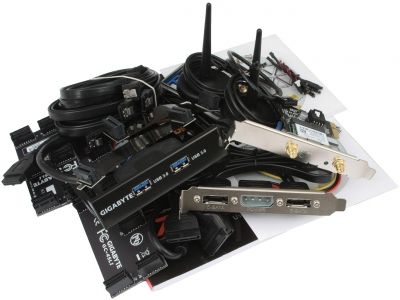
PCB Design and Functionality
Gigabyte mainboards for overclockers are usually designed in black and orange color scheme. The Gigabyte GA-Z77X-UP7 packaging sported these particular colors, and so does the mainboard.
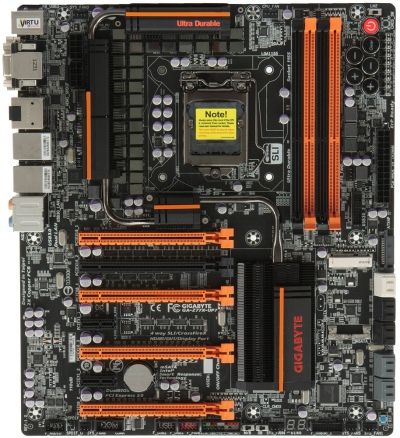
The mainboard is built using Ultra Durable 5 technology, which includes everything typical of previous generation Gigabyte boards, such as 2 oz copper PCB, high-quality electronic components, protection against high temperatures and voltage fluctuations, protection against static and excessive humidity. The major distinguishing feature of this technology, which justified the use of a new number in the name, is the updated component base. Voltage regulator circuitry on Ultra Durable 5 mainboards use IR3550 PowIRstage chips from International Rectifier Company with enhanced characteristics. They are much more efficient and therefore consume less power, heat less and can work under high operational loads. The distinguishing feature of Gigabyte GA-Z77X-UP7 mainboard is a digital processor voltage regulator circuitry of unprecedented power, which works as 32+3+2, with 32 phases allocated for the processor alone. Three – for the integrated graphics core and the remaining two power the VTT. The processor can be powered via two eight-pin ATX12V connectors.
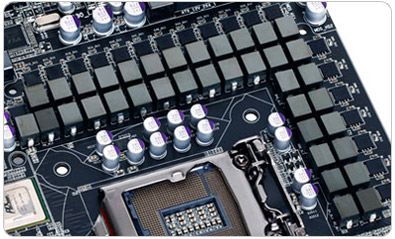
The processor voltage regulator components that warm up noticeably during work are covered with two heatsinks. An L-shaped backplate on the reverse side of the PCB also dissipates some of the heat. The central heatsink cools the PLX PEX 8747 hub that provides additional PCI Express lanes, and the lower heatsink covers the chipset. All four heatsinks are connected into a single cooling contour with three heatpipes and work together. All heatsinks are fastened reliably with screws. They sport “Thin Fin” technology, i.e. their numerous thin fins provide very large heat dissipating surface and are highly efficient.

The PLX PEX 8747 hub expands the list of supported graphics configurations making it comparable with what the Intel X79 Express based mainboards had to offer. Not only one, but two graphics cards may work at full PCI Express 3.0/2.0 x16 speeds, and you can simultaneously use up to four graphics cards maximum at x8 speed. You can build 4-Way/3-Way/2-Way AMD CrossFireX or 4-Way/3-Way/2-Way NVIDIA SLI graphics configurations. We have already seen this additional hub on ASRock Z77 Extreme9, Asus P8Z77-V Premium and Gigabyte G1.Sniper 3. By increasing the slot speed, this hub provides an advantage in multi-card configurations, but lowers the performance a little bit if there is only one card installed, because it produces additional latencies. You don’t really notice this negative effect in the nominal mode, but it does stand out during overclocking. Another important peculiarity of Gigabyte GA-Z77X-UP7 mainboard should eliminate this issue. Namely, the board has a special PCI Express 3.0/2.0 x16 slot for a single graphics card. It is a black slot, unlike the orange slots for the multi-card configurations. It is connected directly to the processor and uses processor PCI Express 3.0/2.0 x16 lanes without involving the hub thus avoiding performance losses when there is only one graphics card in the system. Moreover, there are two PCI Express 2.0 x1 slots for additional expansion cards.
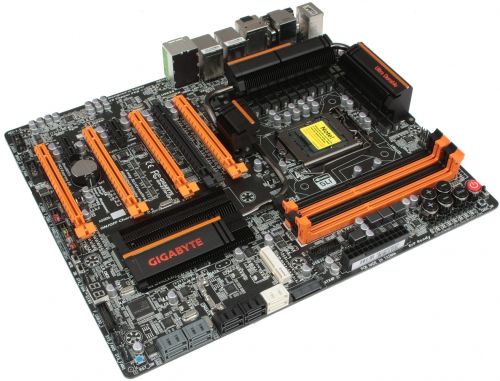
The Intel Z77 Express chipset delivers two SATA 6 Gbps ports (white connectors) and four SATA 3 Gbps ports (black connectors). The distinguishing feature of all Gigabyte mainboards on Intel Z77 Express chipset is the mSATA connector, which is combined with one of the four chipset SATA 3 Gbps ports. Two additional Marvell 88SE9172 controllers provide another four SATA 6 Gbps ports (gray connectors), thus making the total number of SATA devices that can be connected to the board equal to ten.

Overall, we find the following ports and connectors in the back:
- Universal PS/2 connector for mouse or keyboard;
- Two USB 3.0 ports (blue connectors), two internal USB 2.0 pin-connectors and on internal USB 3.0 pin-connector implemented via Intel Z77 Express. VIA VL800 controller adds another four USB 3.0 ports and Etron EJ168 controller – another internal USB 3.0 pin-connector;
- D-Sub, DVI-D, HDMI and DisplayPort video Outs;
- Two local network ports (network adapters are built on Intel 82579V and Atheros AR8161 Gigabit network controllers);
- Optical S/PDIF and six analogue audio-jacks provided by eight-channel Realtek ALC898 codec.
Numerous Video Outs take over a substantial part of the back panel. I doubt they will all be used on an overclocker mainboard, and even more so, on a mainboard that supports an extensive variety of multi-card graphics configurations. Therefore, there was not enough room on the back panel even for eSATA and USB 3.0 ports. However, let’s not forget that that the mainboard comes with a special kit for the back panel including a bracket and cables, which will let you use eSATA devices and power them properly.
Gigabyte mainboards were the first ones to start using two BIOS chips massively, but the DualBIOS technology simply reduced the chances of mainboard failure, but didn’t add any extra functionality to the board, because the user still worked with only one of the BIOS chips and the reserve chip was solely intended for BIOS restore in case the primary one got corrupted. Moreover, this technology would often cause some inconveniences. Sometimes, when the mainboard didn’t start, which was most frequently caused by incorrect overclocking settings, this technology believed that the primary BIOS chip got corrupted and reflashed it. This resulted not only in loss of precious time, but also in loss of all the settings and saved profiles. Other mainboard makers have started using two or even three BIOS chips just recently, but most of them chose a different implementation of this feature. These mainboards have independent microchips leaving it up to the user to decide, which one he or she needs to work with. It is possible to use not only different settings, but even different BIOS versions. The second option is much more user-friendly, because it increases the mainboard’s functionality tremendously. Although in this case, you will have to manually restore the BIOS if one of the chips fails, but it doesn’t happen that often after all, so I am sure users can live with that.
Gigabyte responded to the changing situation immediately, and started equipping some of their mainboards with buttons or switches allowing to select, which BIOS chip to use. Unfortunately, DualBIOS technology continued to work even in this case, and the chips weren’t really independent. For example, during our tests of the Gigabyte GA-X79-UD7 mainboard, we took turns working with the BIOS version F2 and F4. It was very convenient to run tests with different settings profiles, switching instantly between the versions with the help of the “Dual BIOS Switcher” button. However, once we reflashed version F7 into the primary BIOS chip, the BIOS version in the reserve chip was also automatically updated to the latest version. We were simply told that it had been done without any preceding questions whether in fact we needed to do it or not. As a result, we lost all the BIOS settings and settings profiles in the reserve chip. Of course, it was very annoying. However, Gigabyte GA-Z77X-UP7 mainboard we are discussing today, has not only the “BIOS Switcher” switch that allows selecting the active BIOS chip, but also the “DualBIOS Disable” switch, which turns off DualBIOS technology. Moreover, there is also the “LN2 Mode” switch, Power On and Reset buttons, and a set of buttons called “OC Touch”. You can use these buttons to change the base clock and processor clock frequency multiplier on the fly. There is a row of contact point for manual voltage monitoring with a voltmeter, which can be easily arranged with the help of the included adapter-cable set.
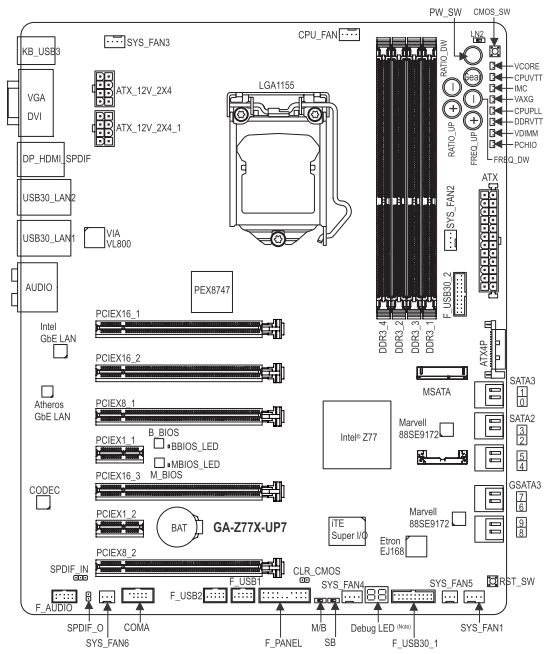
I would also like to add that the board has seven fan connectors, five of which are four-pin ones. The POST-code indicator will help identify the problems during startup. The graphics card slots have very convenient wide latches. All connectors are color-coded and are marked not only on the textolite next to them, but also have their names written inside the COM, USB 2.0 and audio connectors. Engineers had to increase the PCB width to 264 mm in order to fit all controllers, slots and other components.
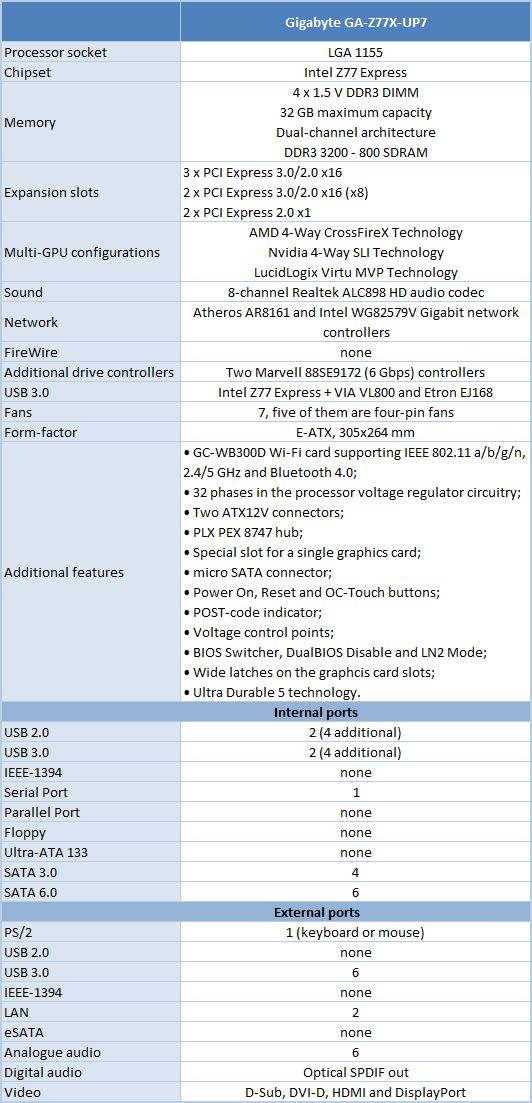
BIOS Functionality
In our previous reviews of Gigabyte mainboards we have already discussed multiple times the functionality of Gigabyte 3D BIOS and the default “3D Mode”. In this mode we see a schematic layout of the mainboard, which key knots are highlighted one by one inviting the user to click on them. It works as a visual hint for the inexperienced users prompting them how they could proceed to adjusting the settings for their processor, memory, voltage regulator, etc.
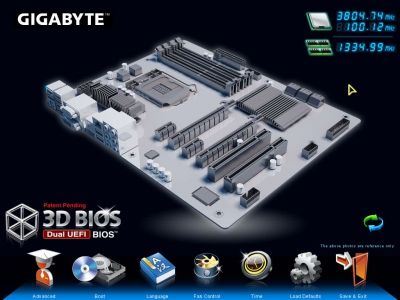
In some cases it is more convenient to work in the visual “3D Mode”, however, the “Advanced Mode” offers more parameters, which we will briefly revise here again.
When you switch to the “Advanced” mode, you get into the “M.I.T.” (MB Intelligent Tweaker) section, which contains all parameters related to overclocking and performance optimizations. The section main screen only lists all sub-sections and reports the basic system data.
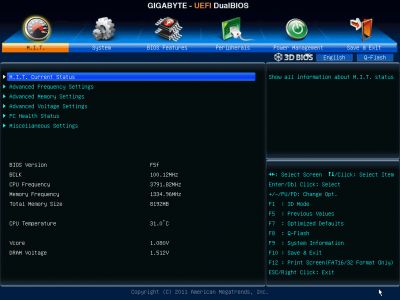
Then we see a purely informational “M.I.T. Current Status” sub-section telling you the current operational parameters of the system.
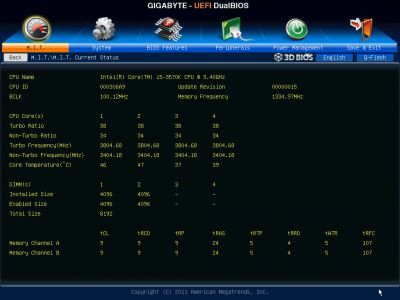
The “Advanced Frequency Settings” sub-section allows you to adjust frequencies and multipliers and there are special informational parameters that will keep you posted about the changes you are making.
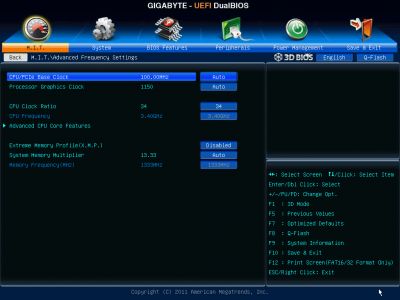
The settings dealing with processor technologies, detailed adjustment of the CPU clock frequency multiplier and power-saving modes are singled out onto a separate page called “Advanced CPU Core Features”.
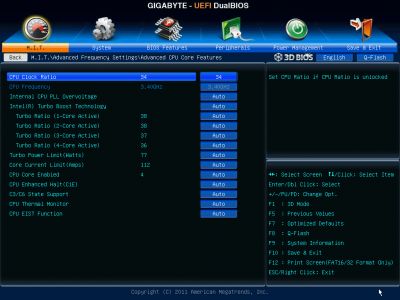
“Advanced Memory Settings” sub-section allows you to fine-tune the memory sub-system.
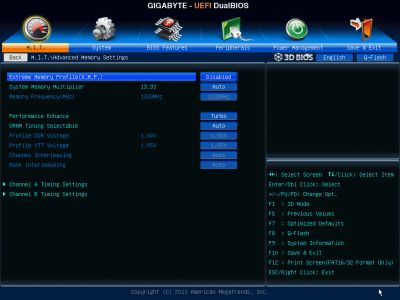
Parameters controlling numerous memory timings are all on separate pages. You can set the timings simultaneously for both memory channels or individually for each one of them.
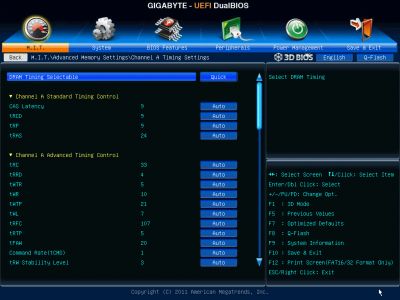
“Advanced Voltage Settings” sub-section allows you to work with different voltages that are all grouped into four separate pages.
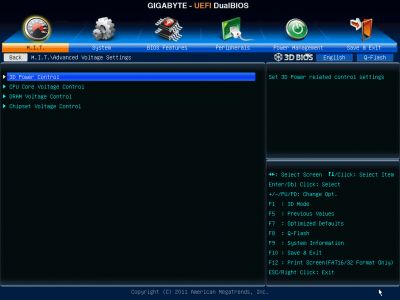
There are a few new parameters in the “3D Power Control” page, which appeared due to the introduction of “3D Power” technology. Now you can set the operational mode for the processor voltage regulator, adjust the level of Vdroop counteraction under heavy load and change a lot of other options right in the BIOS.
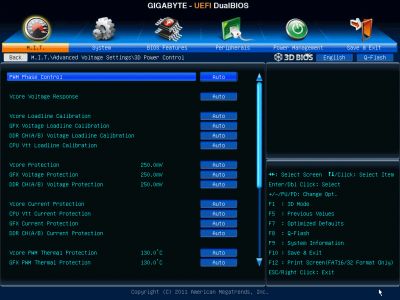
The voltages in different parts of the processor can be changed on “CPU Core Voltage Control” page. The CPU Vcore may be locked at a certain value or you may also add a certain value to the nominal setting.
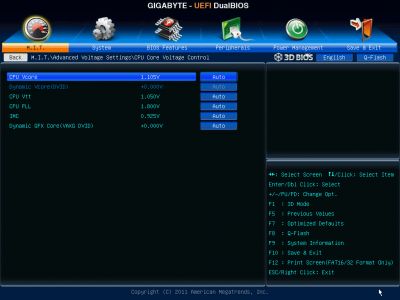
The voltages may be not only increased, but also reduced below the nominal, which may come in very handy sometimes. For example, you may need it if your CPU is functioning at the lower than nominal frequencies or if you are using low-voltage memory modules.
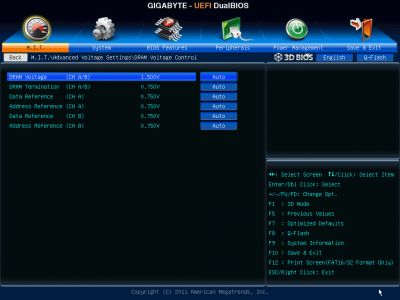
The “Chipset Voltage Control” page is dedicated to only one single voltage.
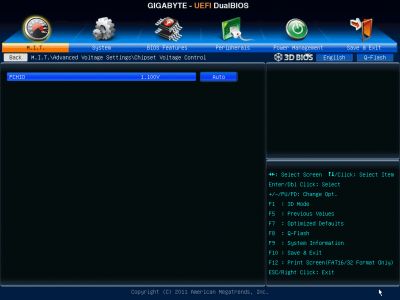
The “PC Health Status” subsection reports current voltages, temperatures and fan speeds. The rotation speed of four fans out of five can be adjusted. You can adjust the rotation speed of the CPU fan and three system fans separately. You can select one of the two preset modes – Normal or Silent – or adjust fan settings manually to your liking. Only the rotation speed of the fourth system fan can be monitored but cannot be adjusted. Unfortunately, if you are using three-pin fans, only the rotation speed of the processor fan and of the first system case fan can be lowered manually, other fan connectors do not support speed adjustment for three-pin fans any more.
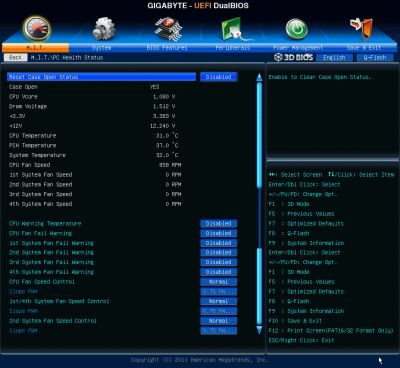
“Miscellaneous Settings” sub-section appeared and remained empty or disappeared completely from Gigabyte mainboard BIOS on several occasions. It turns out this is where you select the operational mode for your PCI Express 3.0/2.0 x16 slots and can therefore improve the performance in certain tests.
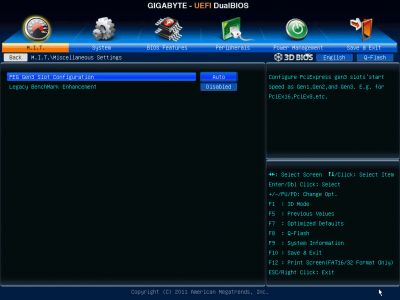
The “System” section is similar to the “Standard CMOS Features” section of the older BIOS. It will tell you basic system information and show the list of connected drives on the “ATA Port Information” page. You can also change the date, time and interface language here.
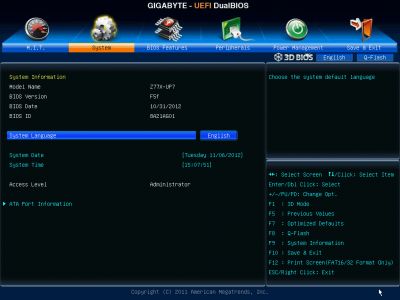
The “BIOS Features” section is where you define your boot devices order, enable the startup picture, control other parameters and technologies, e.g. virtualization, and specify access passwords.
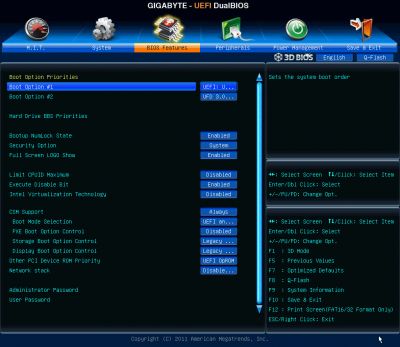
The “Peripherals” section is about external devices and additional onboard controllers. Chipset-specific technologies like Intel Rapid Start and Intel Smart Connect are also configured here.

”Power Management” section contains a conventional set of parameters pertaining to the mainboard power supply and start-up.
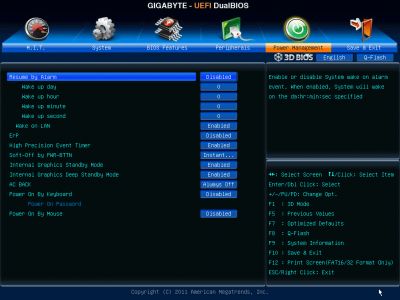
To apply or dismiss your changes you go to the “Save & Exit” section. Here you can also restore default settings. This section also offers you two parameters for BIOS settings profiles management.
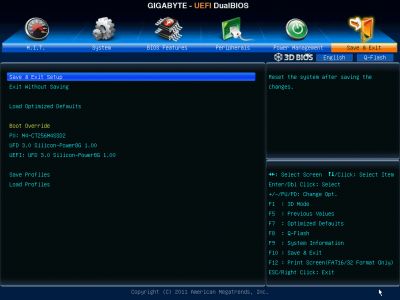
You can save or load up to eight BIOS profiles, assign each of them a descriptive name. You can again save profiles to external media and load profiles from them. Also, the profiles are saved automatically after each successful system startup.

Some of the functional keys still work the same way. Just as before, F9 will bring up system information.
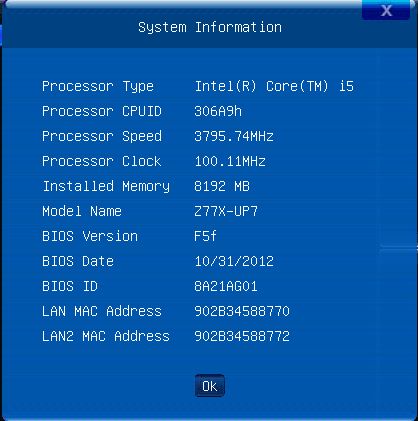
The built-in Q-Flash utility for BIOS updating can be launched by pressing the namesake button or the F8 hot key. It has become more convenient to work with and now shows you both the current BIOS version and the new one you are trying to update to. But it is still unable to work with NTFS disks and the current BIOS version is saved only in the root folder of a disk rather than where you choose to.
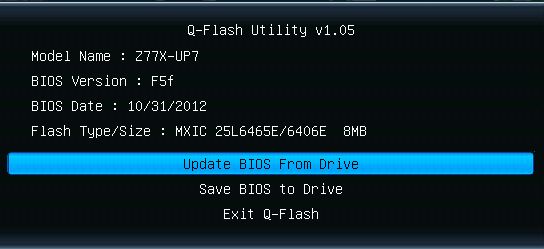
The software team, who have been working on Gigabyte 3D BIOS, have truly earned our absolute respect and praise. Within a relatively short period of time they managed to execute the transition from the old Award BIOS to the new AMI UEFI BIOS. Moreover, they managed to implement almost all the previously existing feature in the new BIOS. The profile management functionality that has been seriously limited in the beginning is now back in its most complete form including work with external media and automatic saving of the latest settings profiles after a successful system startup. They came up with a simple and convenient way to select the active BIOS mode. If you were configuring your system in 3D Mode, this will be the mode you see next time you enter the BIOS Setup, and if your last settings save was in Advanced Mode, then you will get right back to it next time. As a result, after a number of improvements and enhancements the new Gigabyte 3D BIOS offers a full set of parameters for performance optimization, overclocking and simply comfortable overall user experience. Our only comments at this point would be about the way the mainboard works with fans. The option that would allow adjusting the rotation speed of the three-pin processor fan has disappeared yet again. Only two system fan connectors allow lowering the speed of three-pin fans. You can only control the rotation speed of five fans out of seven that can be connected to this mainboard, and the rotation speed of only four of them can actually be adjusted.
Testbed Configuration
We performed all our tests on a testbed built with the following components:
- Gigabyte GA-Z77X-UP7 rev. 1.0 mainboard (LGA1155, Intel Z77 Express, BIOS version F5f);
- Intel Core i5-3570K CPU (3.6-3.8 GHz, 4 cores, Ivy Bridge rev.E1, 22nm, 77 W, 1.05 V, LGA 1155);
- 2 x 4 GB DDR3 SDRAM Corsair Vengeance CMZ16GX3M4X1866C9R (1866 MHz, 9-10-9-27 timings, 1.5 V voltage);
- Gigabyte GV-T797OC-3GD (AMD Radeon HD 7970, Tahiti, 28 nm, 1000/5500 MHz, 384-bit GDDR5 3072 MB);
- Crucial m4 SSD (CT256M4SSD2, 256 GB, SATA 6 Gbps);
- Scythe Mugen 3 Revision B (SCMG-3100) CPU cooler;
- ARCTIC MX-2 thermal interface;
- Enermax NAXN ENM850EWT PSU;
- Open testbed built using Antec Skeleton system case.
We used Microsoft Windows 7 Ultimate SP1 64 bit (Microsoft Windows, Version 6.1, Build 7601: Service Pack 1) operating system, Intel Chipset Software Installation Utility version 9.3.0.1020, AMD Catalyst graphics card driver version 12.4.
Operational and Overclocking Specifics
The system assembly on Gigabyte GA-Z77X-UP7 went smoothly. Unlike the mainboards from some other makers, such as ASRock or Asus, for example, which try to “improve” the processor operational settings and switch to non-standard operational modes by default, Gigabyte GA-Z77X-UP7 ensured nominal settings for all system components: processor, memory, graphics card. Upon system start-up the board displays a start-up image with all the hot-key reminders.
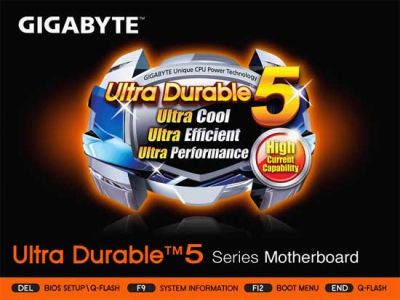
This is also an advantage compared with some other mainboards (for example, from Asus), but as we could see there was no hint to use the “Tab” key, which would normally turn off the start-up image completely and allow you to see the information displayed as we go through the boot-up process. Unfortunately, Gigabyte mainboards display no information at all during the start-up process. The F9 key seems to be a doubtful and unfair replacement, because it displays the same exact info as we can see in the mainboard BIOS. You have to press this key to get access to this info, but nevertheless, there is absolutely no mention of the memory frequency, which is a pity.
We noticed right away that the heatsinks on the processor voltage regulator components were suspiciously warm. Nothing critical: the infra-red Fluke 62 Mini thermometer read 42-43°C on the heatsinks, and maximum 49°C on the voltage regulator itself right next to the heatsinks. Unlike LGA 2011 mainboards, most of which require an additional cooling fan for the components around the processor socket, the heatsinks on LGA 1155 mainboards usually remain cold and warm up a little bit only when the CPU utilization is really high. In our case, the system was working in its nominal mode, but it started feeling warm even when idle. It was very unusual for LGA 1155 mainboards. Therefore, we decided to look into this matter immediately.
At first we confirmed that all Intel’s processor power-saving technologies were working fine. Most of the power-saving parameters in the BIOS were set to Auto, but even when we manually set them to “Enabled”, the system power consumption didn’t change. In other words, unlike the mainboards from some other makers (for example, Micro-Star), all power-saving technologies worked perfectly fine on Gigabyte GA-Z77X-UP7 by default lowering the processor clock frequency multiplier and core voltage, turning off idle processor units and switching it to energy-efficient state in idle mode. This is all great, but it means that we should blame the powerful voltage regulator circuitry with 32 phases for the excessive heating of the components. Large number of processor voltage regulator phases can only do good under heavy CPU load. If it is idle, or isn’t fully utilized, then there is no real need for a multi-phase voltage regulator and it could even become a problem for wasting precious power. To counterbalance this phenomenon many mainboards these days use special technologies that dynamically adjust the number of active voltage regulator phases depending on the current load level. However, we have already seen multiple times that this feature doesn’t really work on contemporary Gigabyte mainboards.
It was back in early 2008 that Gigabyte mainboards came out with rows of LED lights indicating visually how many voltage regulator phases were active at any given moment in time. At first “Dynamic Energy Saver” technology only worked once you launched the namesake utility in the operating system. Later the company implemented this technology in hardware and put it on a variety of mainboard based on different chipsets and designed for different processors. Everything changed in the beginning of this year, when they introduced the new 3D Power technology together with the seventh series chipsets. The transition to new digital voltage regulator circuitry was a great improvement, but it also brought with it at least one drawback: from now on Gigabyte mainboards no longer had Phase LEDs and we couldn’t see any practical effect from the dynamic changing of the number of active phases in the processor voltage regulator circuitry. This time we once again measured the system power consumption with the “PWM Phase Control” parameter set at its maximum “Extreme Performance” setting as well as with the minimal “Light Power” setting, but didn’t see any difference. It could be why Gigabyte GA-Z77X-UP7 consumes more power than regular mainboards, which you will see later in our today’s review. The energy-inefficiency of this particular mainboard model can be only partially explained by the additional PLX PEX 8747 hub, because it consumes more power than mainboards with the same hub onboard, and even more power than any of the Intel Z77 Express based mainboards we have tested so far.
However, we should admit that multi-phase processor voltage regulator is a perfect fit for an overclocker mainboard. It is a real pity that the dynamic adjustment of the number of active phases doesn’t work. This is the reason why the heatsinks are getting warm even in idle mode, which indicates clear waste of power. And do you know how the voltage regulator responded to CPU overclocking and heavy operational load? Well, it hardly responded at all. Remarkably, our overclocked processor loaded with LinX utility, which is a much heavier application than some regular task, has barely affected the readings off the processor voltage regulator. The heatsinks temperature rose from 42-43°C to 44-45°C, and the maximum component temperature next to the heatsinks increased from 49°C to 51°C. In this case the CPU clock speed changed from 1.6 GHz to 4.5 GHz, the total system power consumption almost doubled, but thanks to the exceptionally powerful voltage regulator circuitry on the mainboard it didn’t get affected at all by any of these. I am sure we would have missed this miniscule increase, if we didn’t have an infra-red thermometer on hand.
However, despite all this, we failed to overclock our test processor to its maximum of 4.6 GHz and had to stop at 4.5 GHz. I don’t know about you, but I found it very strange. Until today we had a very simple strategy: we tried hitting 4.6 GHz frequency, and if we failed we lowered our overclocking goal to 4.5 GHz, which was easy to achieve almost on all mainboards we have reviewed so far. However, Gigabyte GA-Z77X-UP7 mainboard seemed to be so powerful and made such a bold statement with its looks and feature set that its inability to overclock our processor to its maximum seemed absolutely unnatural. Therefore, this time we decided to make an extra effort and run additional tests.
We always overclock mainboards in such a way that they could be used permanently in this mode. Therefore we do not try to make our life easier by disabling any of the mainboard’s features, e.g. onboard controllers, and try to keep the CPU’s power-saving technologies up and running. However, traditional processor overclocking recommends disabling all unutilized controllers and functions, including the power-saving modes. After that you should lock the processor frequency. The processor Vcore should also be set at a permanent fixed value. And only then you can proceed to stability tests. If you can’t achieve stability, then you should raise the Vcore. If the temperature increases too much, then you should lower the clock frequency. After all of that tweaking, you end up with a stable overclocked system.
I really wanted to say that this approach produced great outcome momentarily, but I have to admit that it didn’t work out that well at first. The thing is that I haven’t used this primitive overclocking algorithm for years and therefore was setting the core voltage too low at first. However, once I found that balance between the processor core voltage and Vdroop, things came together rapidly. I didn’t time myself, but it felt like it had taken me less than an hour to get a stable and reliable system working at 4.6 GHz. Just for your information, I spent an entire day trying to find optimal parameters for energy-efficient overclocking, but had to stop at 4.5 GHz. So, what was different this time? And the only difference is the system power consumption in idle mode, which equaled a little over 80 W with power-saving technologies enabled, and increased to 110 W with power-saving technologies disabled. This is exactly why we believe it is unacceptable to overclock while disabling all power-saving technologies.
I am sure you understand the difference between reasonable use and waste of power. When you have five lights on in your room, but that much light is necessary to read, draw, stitch or do anything else that requires good lighting, it is OK. But it is wrong to have the light on in an empty room, because someone simply forgot to turn it off. The same is true for computers. If the system consumes 100, 200 or even a 1000 W, it is OK as long as this power is used efficiently, and it doesn’t really matter if it is used for work or for entertainment. However, it is unacceptable to overclock your system without retaining the power-saving technologies. Yes, it is much easier to succeed when overclocking in this manner, but it will most likely satisfy only young teenagers, whose maximalism requires getting results at any cost. They sincerely believe that only movie super-heroes can save the world and do not yet realize that they could also contribute to maintaining ecological balance by simply turning off the light or overclocking while keeping power-saving technologies up and running. This is why for years we have been encouraging users to approach overclocking in a reasonable, thought-through and balanced manner and keep power-saving technologies up and running. In our opinion, this overclocking is truly worthy of a responsible adult. Yes, it is more complicated, because instead of one fixed frequency at one fixed voltage setting, you have to ensure stability in a broader frequency interval with constantly changing voltage. It is indeed harder to succeed with so many variables and the obtained results may often be lower than during overclocking “at any cost”, but this is the right way.
We cannot explain why some boards overclock better and some worse. So far, only ASRock mainboards have been continuously overclocking our test processor to its maximum frequency of 4.6 GHz. Not all Asus boards, and not all Gigabyte boards did the same. Micro-Star mainboards seem to be unfit for energy-efficient overclocking. They cannot increase the processor core voltage in Offset mode, i.e. by simply adding a desired value to the nominal setting. MSI boards can only set the core voltage at a fixed value. Yes, it is easier to overclock this way, but all power-saving technologies will be turned off. Therefore, optimal overclocking on Micro-Star mainboards is only possible without changing the processor Vcore. In fact, it is a pretty good option, too, and I personally always do it this way on my home computer systems, because in this case you boost the performance almost without any increase in the system power consumption. However, when we review products, we have to fully uncover the potential of the tested boards that is why we also increase the voltages, but do whatever it takes to keep all power-saving technologies up and running.
There were reports about Gigabyte GA-Z77X-UP7 setting an overclocking record for an Intel Core i7-3770K processor, which managed to hit 7.102 GHz frequency. Of course, this frequency was reached with extreme cooling methods involving liquid nitrogen and with all extras disabled for good, including the power-saving modes. Yes, this record-breaking frequency does show high overclocking potential of this product, but our specific Intel Core i5-3570K processor could only be overclocked to 4.5 GHz.
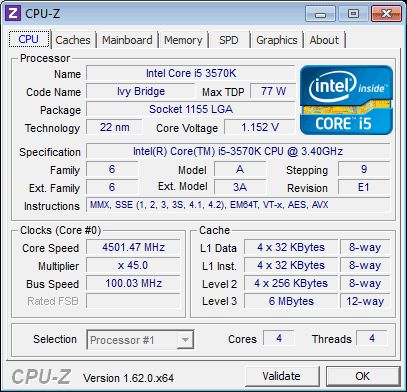
At the same time we increased the memory frequency to 1867 MHz and corrected its timings accordingly.
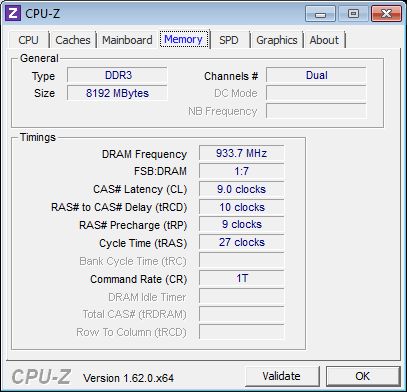
And of course, we overclocked our system in such a way that it could be used permanently in this mode. We did not disable any of the mainboard’s additional controllers and kept CPU’s power-saving technologies up and running. As a result, they lowered the processor clock frequency multiplier and core voltage, turned off idle processor units and switched it to energy-efficient state in idle mode.
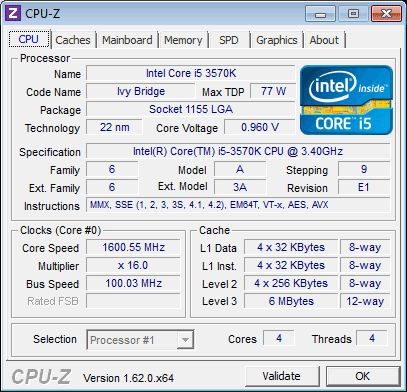
Performance Comparison
As usual, we are going to compare the mainboards speeds in two different modes: in nominal mode and during CPU and memory overclocking. The first mode is interesting because it shows how well the mainboards work with their default settings. It is a known fact that most users do not fine-tune their systems, they simply choose the optimal BIOS settings and do nothing else. That is why we run a round of tests almost without interfering in any way with the default mainboard settings. For comparison purposes we also included the results of the previously reviewed mainboards:
- ASRock Fatal1ty Z77 Professional
- ASRock Z77 Extreme4 and ASRock Z77 Extreme6
- ASRock Z77 Extreme9
- ASRock Z77 OC Formula
- Asus Maximus V Formula
- Asus P8Z77-V Deluxe
- Asus P8Z77-V LX
- Asus P8Z77-V Premium
- Asus Sabertooth Z77
- Gigabyte G1.Sniper 3
- Gigabyte GA-Z77X-UD3H and GA-Z77X-UD5H-WB WIFI
- Gigabyte GA-Z77X-UP4 TH and Gigabyte GA-Z77X-UP5 TH
- Intel DZ77BH-55K
- Intel DZ77GA-70K and Intel DZ77RE-75K
- MSI Z77A-GD65.
The results on the diagrams are sorted out in descending order. The results of Gigabyte GA-Z77X-UP7 mainboard are highlighted with a darker color for your convenience.
Nominal Mode
We used Cinebench 11.5. All tests were run five times and the average result of the five runs was taken for the performance charts.
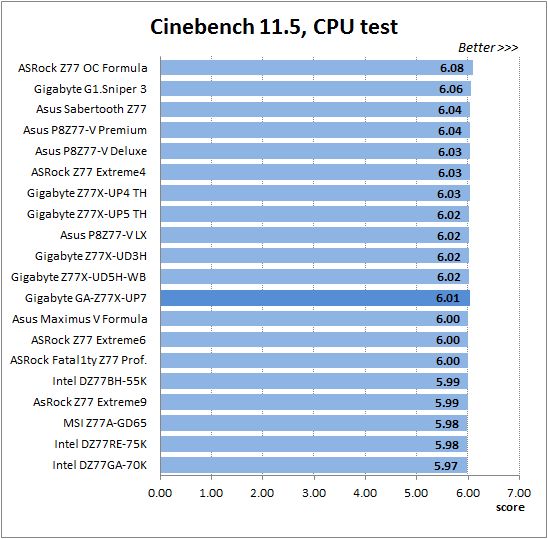
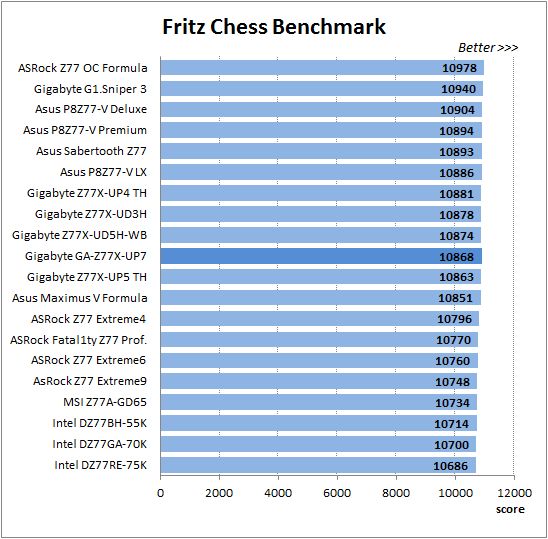
A small video in x264 HD Benchmark 4.0 is encoded in two passes and then the entire process is repeated four times. The average results of the second pass are displayed on the following diagram:
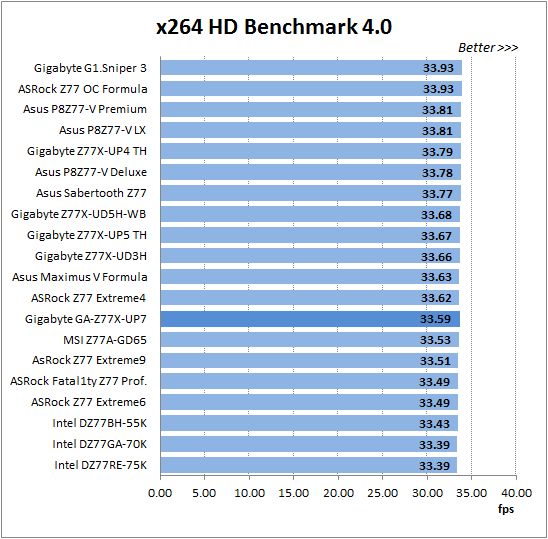
We measured the performance in Adobe Photoshop using our own benchmark made from Retouch Artists Photoshop Speed Test that has been creatively modified. It includes typical editing of four 10-megapixel images from a digital photo camera.
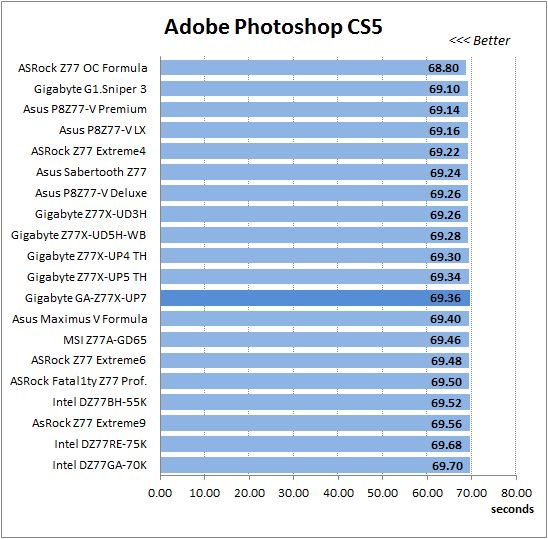
In the archiving test a 1 GB file is compressed using LZMA2 algorithms, while other compression settings remain at defaults.
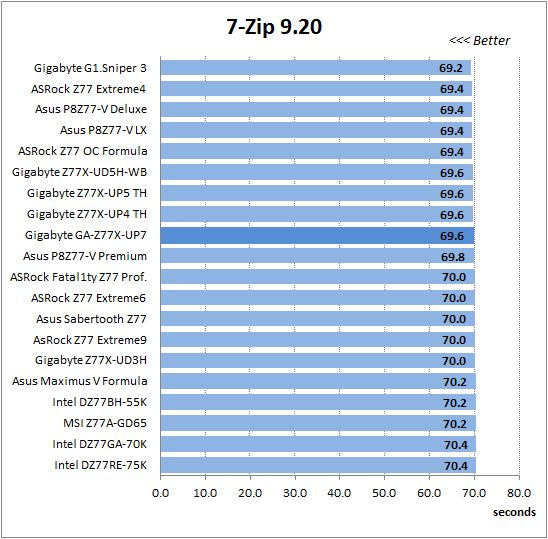
Like in the data compression test, the faster 16 million of Pi digits are calculated, the better. This is the only benchmark where the number of processor cores doesn’t really matter, because it creates single-threaded load.
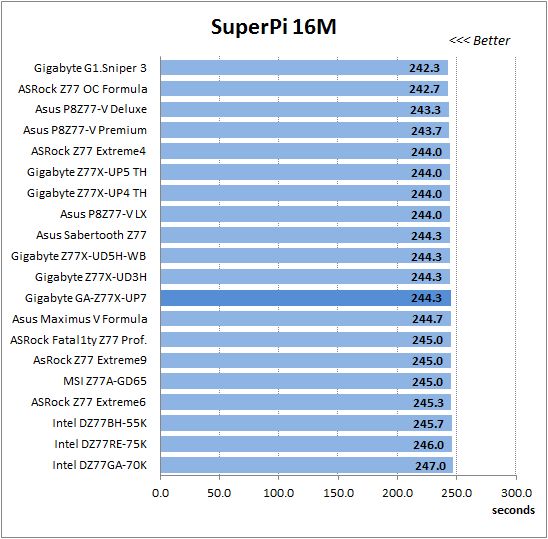
Since we do not overclock graphics in our mainboard reviews, the next diagram shows only CPU tests from the 3DMark11 – Physics Score. This score is obtained in a special physics test that emulates the behavior of a complex gaming system working with numerous objects:
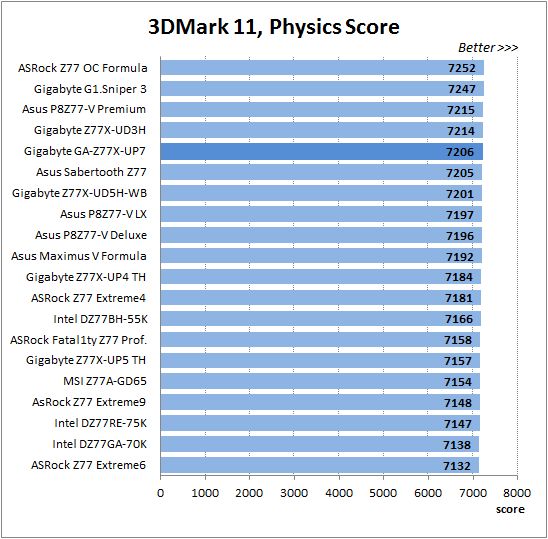
We use FC2 Benchmark Tool to go over Ranch Small map ten times in 1920×1080 resolution with high image quality settings in DirectX 10.
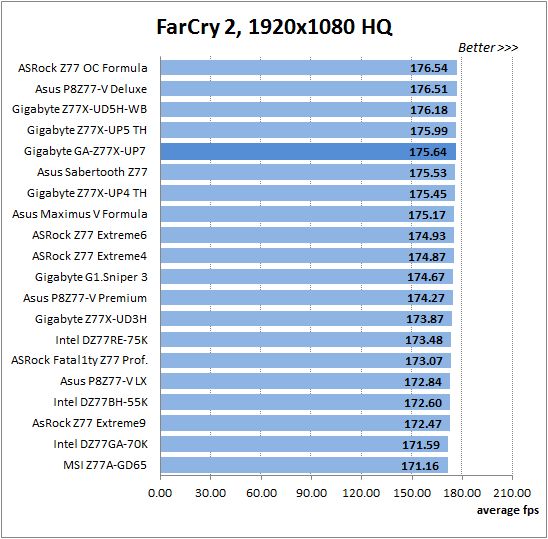
Resident Evil 5 game also has a built-in performance test. Its peculiarity is that it can really take advantage of multi-core processor architecture. The tests were run in DirectX 10 in 1920×1080 resolution with high image quality settings. The average of five test runs was taken for further analysis:
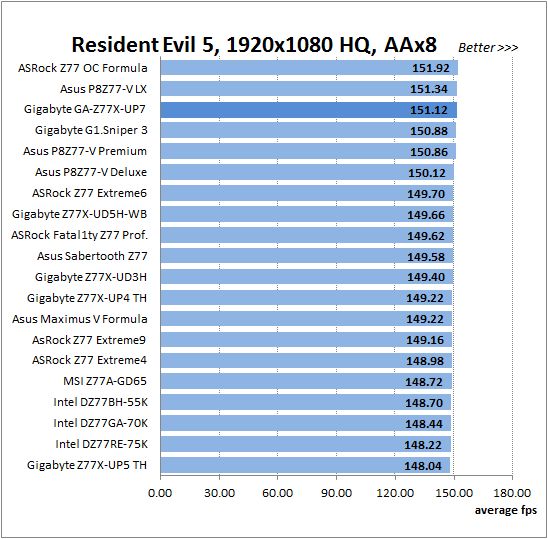
Batman: Arkham City game also reacts eagerly to any changes in the CPU clock frequency, but it uses DirectX 11. We ran game’s integrated benchmark five times with high image quality settings and then take the average of the five runs for the diagrams.
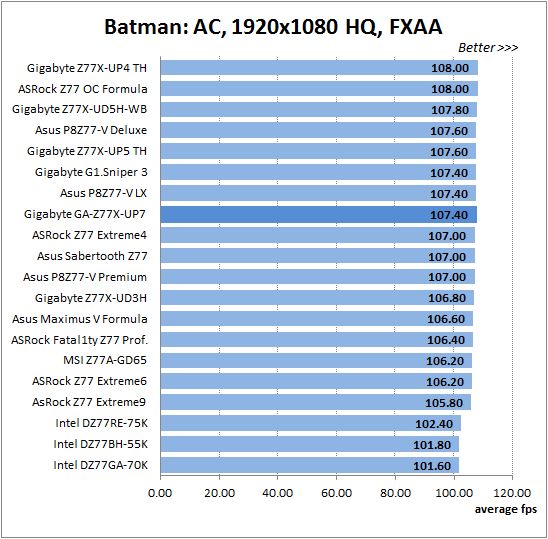
We see a great illustration of the known fact that related mainboards working in identical testing conditions demonstrate about the same performance. Therefore, it is not surprising that the performance of Gigabyte GA-Z77X-UP7 in the nominal mode is very similar to the performance of the other participants.
Overclocked Mode
During processor and memory overclocking, different mainboards accomplished different results, which we summed up in the following table for your convenience:
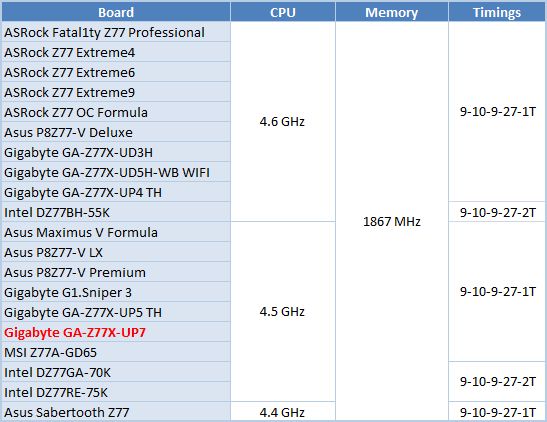
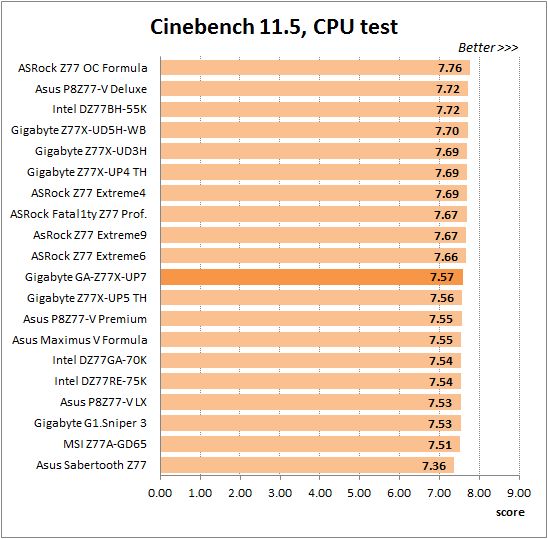
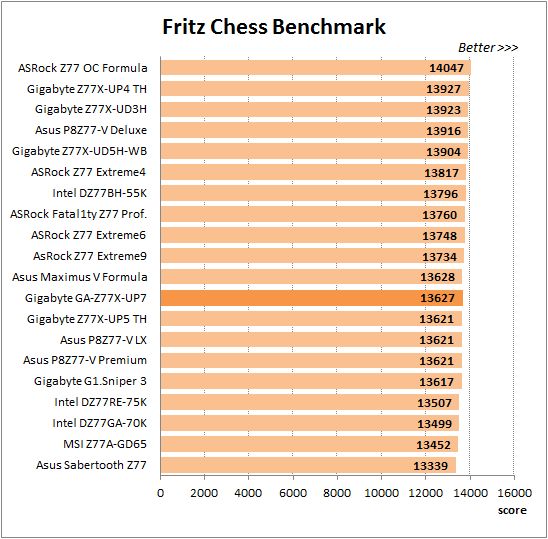
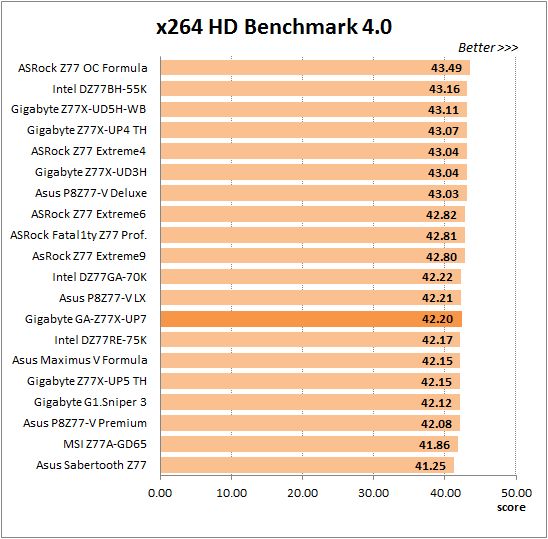
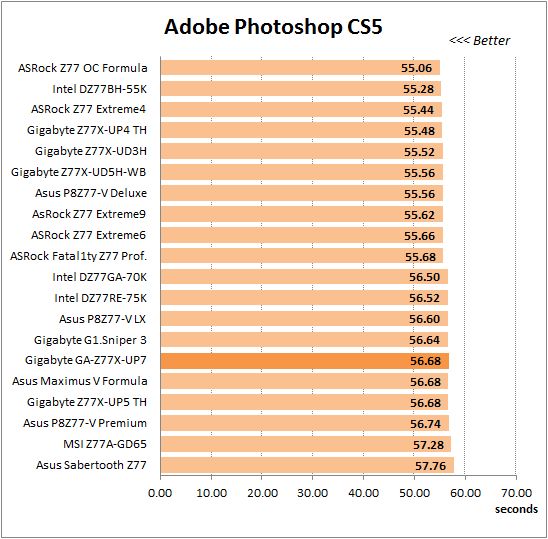
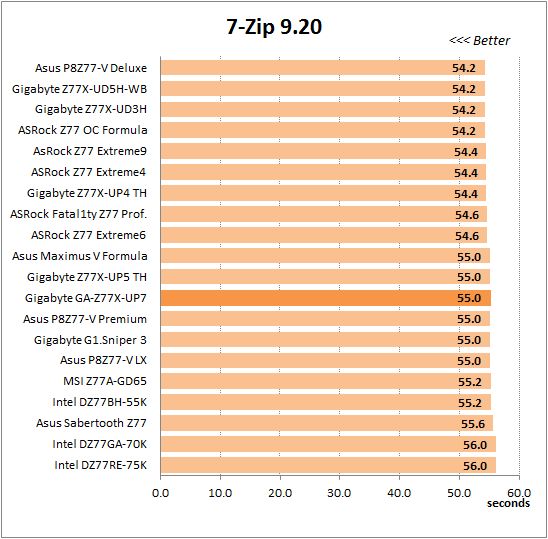
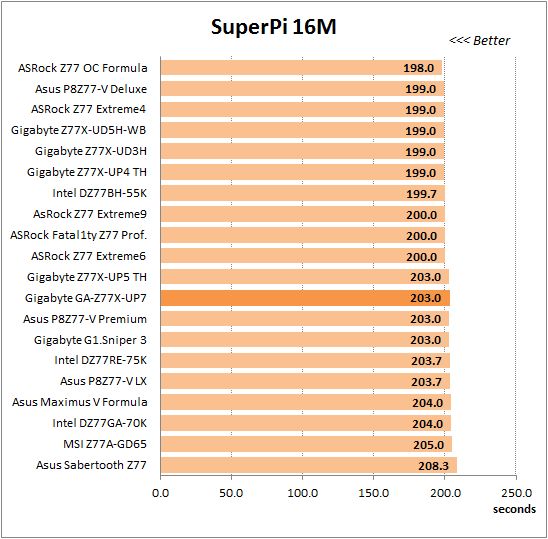
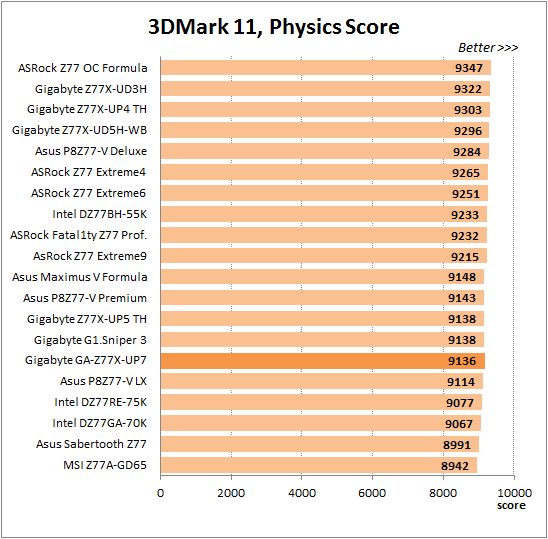
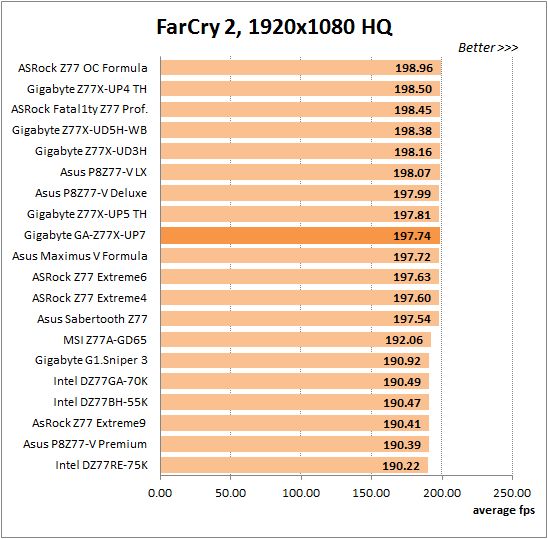
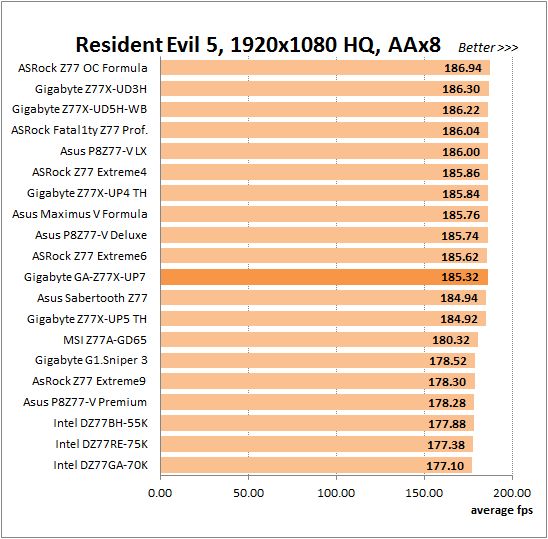
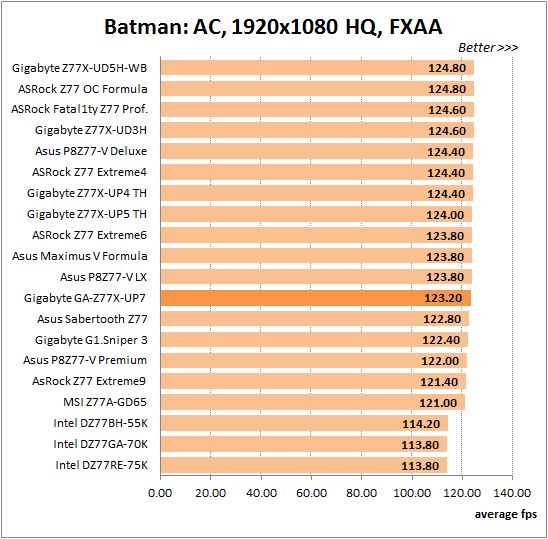
Gigabyte GA-Z77X-UP7 performance during overclocking is an appropriate match for the obtained results in this mode, however, I would like to draw your attention to the last gaming tests and compare the obtained results against those of ASRock Z77 Extreme9, Asus P8Z77-V Premium and Gigabyte G1.Sniper 3. All these mainboards have one thing in common: the additional PLX PEX 8747 hub. As you can see, they all demonstrate very similar results, which do not depend on overclocking and are a little lower than originally anticipated. In all these cases, it is the hub latencies that cause this. These mainboards are designed as solutions for multi-card graphics configurations, when faster slot speed makes up for these minor latencies. However, when there is only one graphics card installed into a system, the negative effect from the latencies is obvious. However, if we look at the performance of Gigabyte GA-Z77X-UP7 in these games, we will see that it is very similar to that of the regular mainboards and is significantly higher than that of the other three products with the same hub onboard. All this was possible due to a special connector tied directly to the processor, which uses processor PCI Express lanes avoiding the additional hub. This allows maintaining high slot speed when there is only one graphics card in the system.
Power Consumption
We performed our power consumption measurements using an Extech Power Analyzer 380803. This device is connected before the PSU and measures the power draw of the entire system (without the monitor), including the power loss that occurs in the PSU itself. In the idle mode we start the system up and wait until it stops accessing the hard disk. Then we use LinX to load the CPU. For a more illustrative picture there are graphs that show how the computer power consumption grows up depending on the number of active execution threads in LinX (both at the default and overclocked system settings). The results of Gigabyte GA-Z77X-UP7 are marked with darker color for your convenience.
Because of compatibility issues we uncovered in Gigabyte GA-Z77X-UP4 TH and Gigabyte GA-Z77X-UP5 TH mainboards with our original CoolerMaster RealPower M850 power supply unit, we had to replace it with Enermax NAXN ENM850EW. Both these PSUs have very similar technical characteristics, but Enermax NAXN ENM850EWT is about 1-3 W more energy-efficient than the Cooler Master unit. In order to be able to use the previously obtained results, we decided to make up for this efficiency difference by adding 2 W to all new power readings, so that we could still compare their results against the power consumption of all previously tested products.
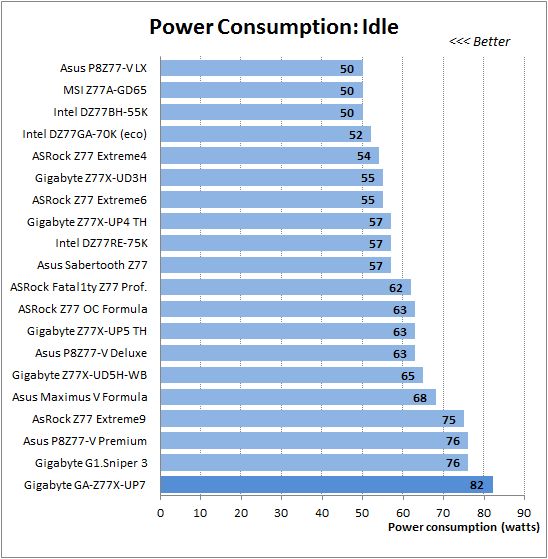
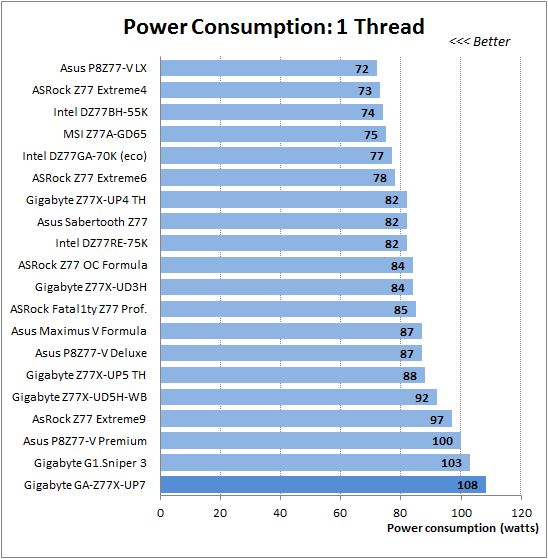
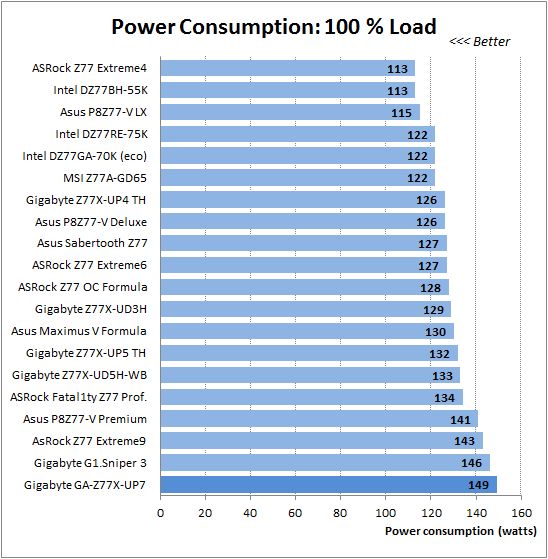
As have already said, that Gigabyte GA-Z77X-UP7 consumes more power than regular boards. The PLX PEX 8747 hub is only responsible for some of this power consumption, because this mainboard still consumes more power than other mainboards with the same hub, or even any other Intel Z77 Express based mainboard, which we have already reviewed. This is the price you have to pay for the super-powerful 32-phase processor voltage regulator circuitry and for the non-operational dynamic adjustment of the number of active phases depending on the operational load.
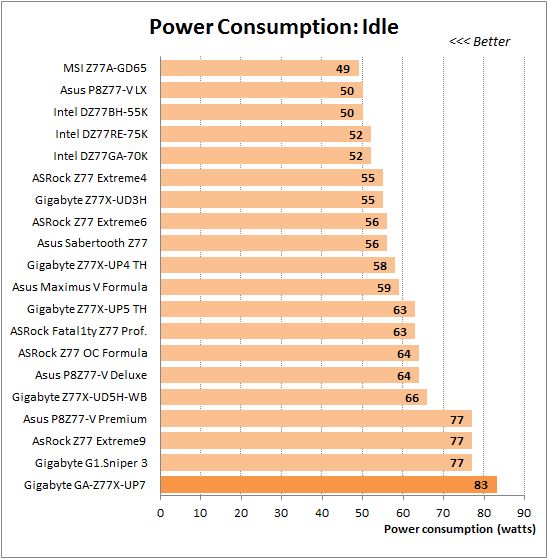
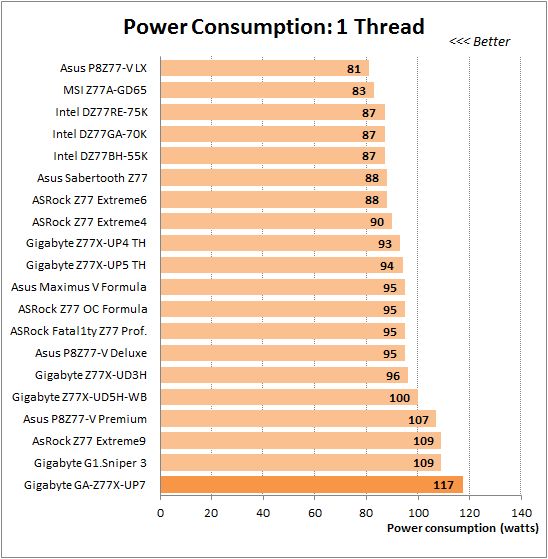
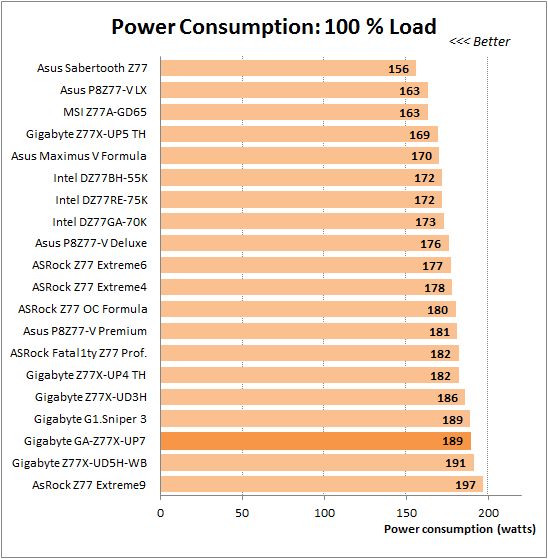
We see the exact same thing during overclocking. Only in case of maximum CPU utilization two mainboards had higher power consumption than Gigabyte GA-Z77X-UP7. ASRock Z77 Extreme9 shouldn’t be ashamed, because it overclocked our test processor to the maximum and therefore it worked at higher voltage, which naturally results into higher power consumption. However, it looks like Gigabyte GA-Z77X-UD5H-WB WIFI has an even less efficient voltage regulator. It has fewer processor phases, but it is designed as an Ultra Durable 4 product, i.e. uses less energy-efficient MOSFET.
Conclusion
Throughout this review we pointed out a few shortcomings of the Gigabyte GA-Z77X-UP7 mainboard, but we have to conclude that nevertheless, it is a very good product overall. While its advantages are indeed numerous, the shortcomings are really few. The first one refers to the way this board work with the fans, which could have been better. It doesn’t allow to adjust the rotation speed of the three-pin processor fan, only two system fan connectors allow lowering the fan rotation speeds. Only five fans out of seven that can be connected to this mainboard can be controlled, and only four of them are adjustable. The second shortcoming is that numerous video Outs take up a lot of space in the mainboard back panel. We doubt that they will all be used on an overclocker mainboard, and especially on a mainboard supporting advanced multi-card graphics configurations. However, this is why there was no room left on the back panel for USB 2.0 and eSATA ports. Although, you shouldn’t forget that the board comes with a kit including cable and bracket for two external Serial ATA devices, which kind of makes up for this shortcoming. And finally, the major issue is the processor voltage regulator that is unable to dynamically change the number of active phases depending on the workload at a given moment of time. This, as well as many phases in the circuitry, makes Gigabyte GA-Z77X-UP7 the most power-hungry of all our testing participants.
However, all the above mentioned cons become significant only when we consider Gigabyte GA-Z77X-UP7 for a quiet and energy-efficient home system. However, the mainboard’s primary purpose is still overclocking. In this respect, all the above mentioned drawbacks are not that critical at all. It doesn’t really matter that we cannot adjust the rotation speed of all cooling fans connected to this mainboard, because they will most likely work at their maximum speed anyway to ensure the highest overclocking scores. The exceptionally powerful processor voltage regulator circuitry with 32 phases immediately turns into an obvious advantage, because it is claimed to be able to withstand up to 2000 W, according to a marketing video. We have already seen overclocker mainboards and mainboards equipped with an additional hub, which are positioned as solutions for multi-card graphics configurations. Gigabyte GA-Z77X-UP7 has the best of both worlds. Moreover, a special graphics card slot directly connected to the processor will ensure the highest possible speed even when there is only one graphics card installed.
So, Gigabyte GA-Z77X-UP7 will primarily interest overclocking enthusiasts who like to experiment, break records, and use either one or multiple graphics cards, depending on their ultimate goals. Gigabyte GA-Z77X-UP7 is a practically ideal choice for any of these tasks. But, it will also be a great option for a powerful home system, provided you disregard a few minor drawbacks pointed out above.
That said, we are proud to award Gigabyte GA-Z77X-UP7 our Ultimate Innovation title for all the superb technologies and features packed into one single product:
